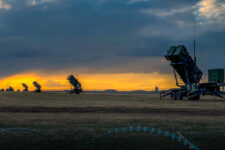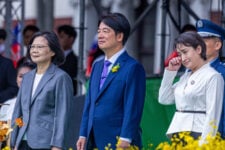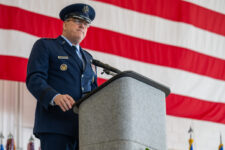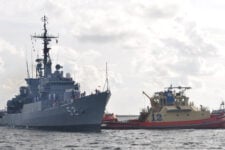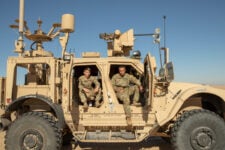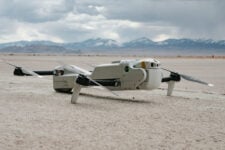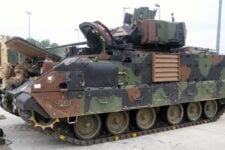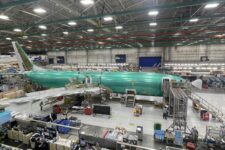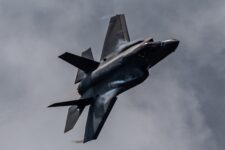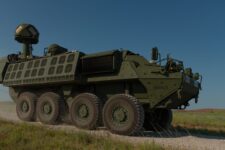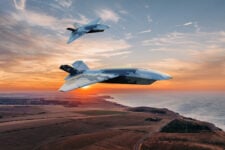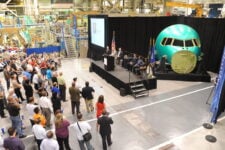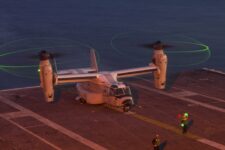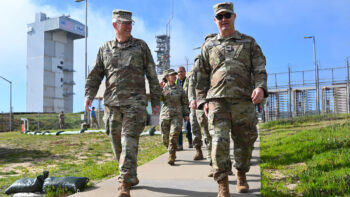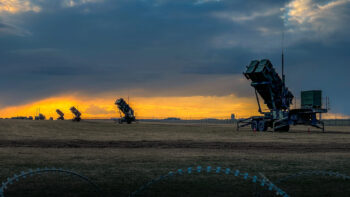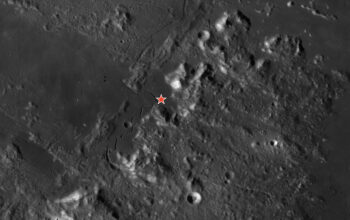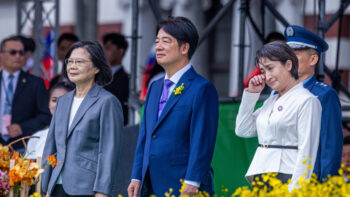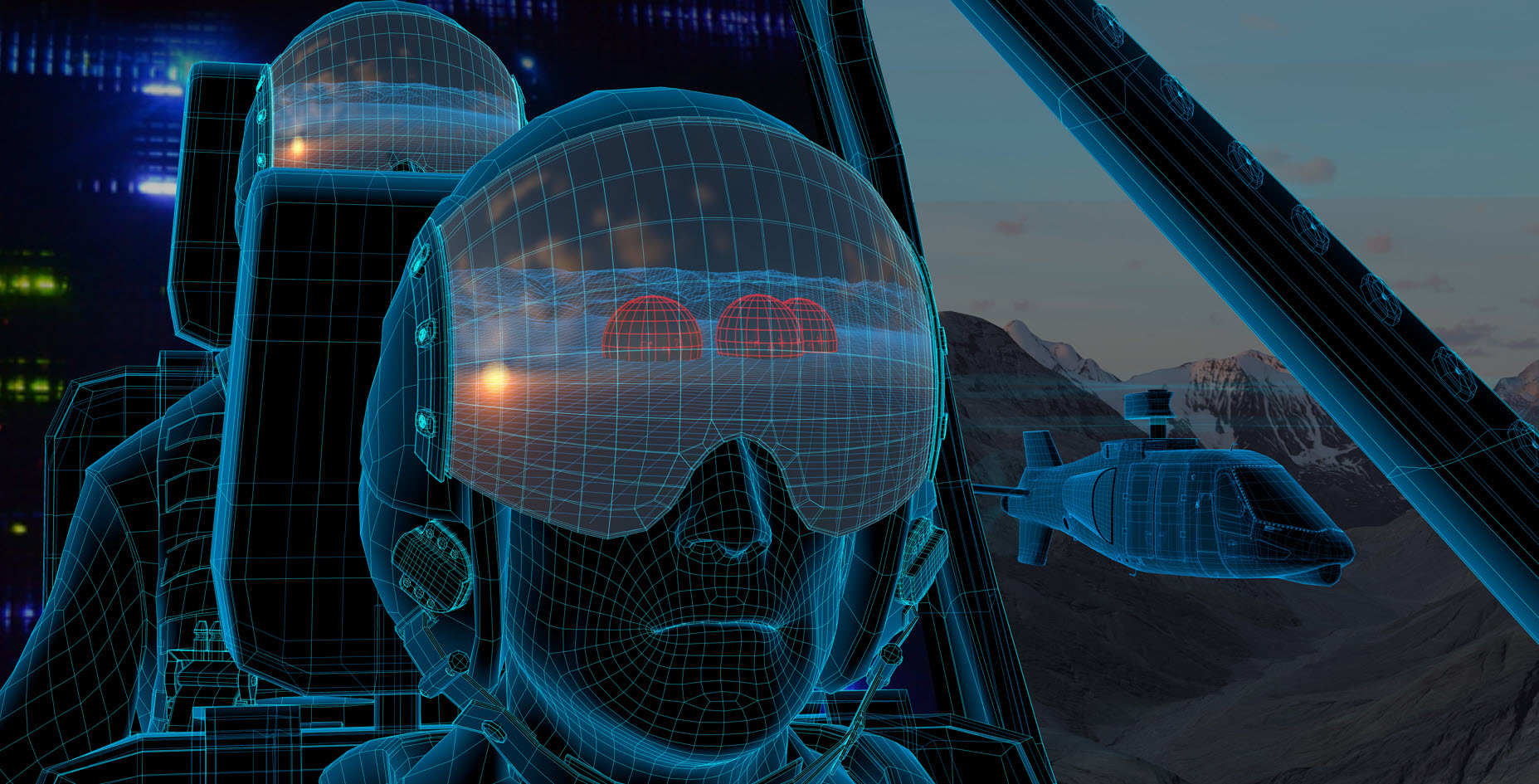
One of the leading edge opportunities to utilize RAIVEN will be RAIVEN Turret 1000, first in a new family of EO/IR systems that Raytheon plans to offer for Future Vertical Lift. Shown is a Raytheon conception of a next-generation platform.
In this Q&A with Torrey Cady, vice president of Surveillance and Targeting Systems at Raytheon Intelligence & Space (RI&S), and Jake Ullrich, director and chief engineer of Surveillance and Targeting Systems at RI&S, we discuss: the new RAIVEN architecture that brings better standoff range to EO/IR systems and is specifically designed for multi-mission effectiveness and survivability in new platform programs like Future Vertical Lift (FVL) and many others.
Breaking Defense: RAIVEN is a next-generation EO/IR product and platform-agnostic family architecture. Before we get into the details, what’s the threat scenario today that demands better EO/IR?
Cady: We’re fighting adversaries that potentially have peer-to-peer capabilities. Because of that, pilots must be able to identify numerous threats coming from all directions. The earlier we’re able to identify those threats, the more survivable we will be.

Torrey Cady, Vice President of Surveillance and Targeting Systems at Raytheon Intelligence & Space.
First, we need to increase range. The emerging peer-to-peer battlespace challenges the traditional role that EO/IR has played in the past, which primarily consisted of providing surveillance video feeds to commanders, pilots and operators on what is essentially a TV screen. We need more standoff range and capability from EO/IR to provide better survivability to pilots.
We looked at various platforms and current capabilities of EO/IR systems, and we did a combined gap and operational analysis to identify the capabilities that a future EO/IR system needs to have to provide technological overmatch and improve survivability in that environment by identifying targets before threats are able to identify them.
Second, we need to make it easier for operators and pilots to ingest an overwhelming amount of data. We need to reduce pilot and operator workload. The result is RAIVEN.
RAIVEN addresses the range issue by increasing the optical range within the same SWaP as our existing MTS (Multi-Spectral Targeting System)-class turrets.
RAIVEN also adds a new capability that provides not only a new detection means but adds range beyond the ability of traditional optically based sensors — hyperspectral imaging (HSI) with real-time onboard processing. HSI has largely been an experimental type technology that required collection of data and post-mission processing. We are changing that to offer a new method to detect, recognize and identify things previously undetectable through purely optical means.
For context, we are talking five times the detection, recognition and identification range in the same SWaP as compared to existing optical imaging today.
RAIVEN integrates LiDAR into the turret reducing the number of federated boxes on the platform and improving SWaP-C at platform level while simultaneously reducing operator and pilot workload because they have one less independent system to operate.
And finally, RAIVEN solves the data overload challenge because all of our traditional multispectral sensors, as well as the added capabilities of HSI and LiDAR, are fed into our new on-board processing capability that uses artificial intelligence and machine learning to automate the detect, recognize, identify and prioritize process that greatly improves platform survivability and reduces operator workload.
Our solution provides accurate and persistent target observation, accelerated information sharing, and improved survivability to the platform and the pilot through both standoff range and aided target recognition, which also reduces the operator workload in the cockpit.
Breaking Defense: Describe RAIVEN. Is it an acronym?
Ullrich: RAIVEN is not an acronym but rather a play on words. We’re known for the Multi-Spectral Targeting System that I just mentioned, which combines EO/IR, laser designation and laser illumination capabilities in a single sensor package. The new RAIVEN architecture brings new technology building blocks for our next-generation EO/IR systems and answers the threat that Torrey just talked about. For that reason, we wanted a new name that symbolizes something intelligent, stealthy and a bit mysterious.

Jake Ullrich, Director and Chief Engineer of Surveillance and Targeting Systems at Raytheon Intelligence & Space.
We started with the word “raven” for the bird and added “AI” in the middle. Ravens are good at what they do — they’re smart hunters, staring at their prey all day and night long — but now, as Torrey said, we’ve got to do that in a smarter way. There’s so much sensor data that needs to be consolidated that artificial intelligence and advanced processing plays a key role in this next-generation technology suite and architecture.
We’re very good at integrating disparate systems, and RAIVEN is a new foundation for doing that. It starts with new software, electronics, and sensors. It’s a clean sheet that we can now instantiate into different products. At the same time, we can play those back into some of our existing products where it makes sense.
It’s not one product; it’s an architecture that’s platform agnostic with adherence to open standards that gives us the tools, flexibility and common elements that we can embed into different products.
Breaking Defense: RAIVEN uses hyperspectral imaging, LIDAR, and advanced processing to improve platform survivability and deliver the right information to help commanders make decisions faster in contested environments. How does RAIVEN improve platform survivability?
Cady: Speaking from personal experience, there’s complete sensory overload when you’re in contact with the enemy in a combat situation, especially for pilots who are trying to fly platforms, figure out the right targets to attack first, and survive as some of those targets are trying to attack them.
When we add different sensors and various systems to an aircraft, a pilot can very quickly become overloaded with information. That makes it tough to make a decision, and it can create a bit of analysis paralysis. We’re trying to automate what used to be a more visual interpolation of the data. Previously streaming full motion video, for example, required the viewer to visually identify things on the video and make decisions based on what they’re seeing.
We will now automate that process through aided target recognition and onboard processing through all of our sensors so that it will be very clear based on the rules of engagement what types of threats they’re seeing out there and which targets represent the biggest threat to the pilot. That automation reduces the workload for the pilot, enabling them to concentrate on surviving.
Breaking Defense: How does RAIVEN address operations in contested environments?
Cady: We’ve typically relied on optical sensors in the past. With the addition of hyperspectral, LiDAR and other sensors, we now have multiple means for sensing the threats. We’re not relying strictly on one mode to sense a threat.
In the past, if you’re just using video and a threat was concealed through foliage, you might not be able to identify that threat on video. Hyperspectral imaging with real-time processing will enable pilots, operators and commanders to identify obscured targets with as little as one single pixel based on their “spectral fingerprint”. Traditional EO/IR systems rely on the ability of an operator or pilot to visually recognize a shape which requires that the majority of it be unobscured.
Ullrich: Hyperspectral sensors allow us to “see differently” by identifying material and chemical signatures of these threats despite being concealed. If you think about these different bands across the spectrum where an adversary is trying to prevent our forces from seeing by jamming the radar, for instance, one of the advantages of EO/IR and one of the reasons it’s being employed more in those scenarios is because of its passive nature. It can stare quietly and undetected.
Because we can see across so many different bands, they’re given a picture that you may not have had before because you had to be quiet and couldn’t turn on your radar or your SIGINT. We’re giving the pilot and operators additional means for identifying the threat in a contested battle space. The passive elements of EO/IR integrated with the platform and other sensors bring a battlefield advantage that they didn’t have before.
Cady: If our forces are radiating, they can see them, too. Having the ability to decide when they want to radiate and still have sensors that can identify threats at a meaningful range without having to radiate is another key aspect.
Defense: The capabilities you’ve been describing are enablers that next-generation programs like Future Vertical Lift need to meet their parameters for speed and mission effectiveness. How so?
Cady: As Jake mentioned, RAIVEN is more than just a product; it’s an architecture, and we’re planning to use the elements of RAIVEN on multiple products for multiple missions and platforms.
One of the leading-edge opportunities to use RAIVEN will be the RT-1000 turret that we’re planning to offer for FVL. By investing heavily in the capabilities that we’ve been talking about, like hyperspectral and onboard processing with AI/ML, we’re getting away from federated boxes that add size, weight, power and cost to a platform because each box only does one thing.
Integrating these technologies into a single system will reduce overall cost and increase weapon-system performance and platform survivability. Along with hyperspectral imaging, LiDAR, AI/ML, and some elaborate packaging, RAIVEN and the RT-1000 will bring the largest optical aperture for long-range imaging than has previously been offered in this size gimbal or turret. Aperture equals range that is critical for a passive system like EO/IR.
The result will be unprecedented awareness of the battlespace for the platform, which enables increased standoff range and survivability in contested environments. These are some of the discriminators that RAIVEN is going to have that would be very important for the two Future Vertical Lift platforms.
Ullrich: For FVL, the Army wants new and innovative technology that’s going to transform their platforms into multi-mission and multi-function weapons systems. One such technology is the RT-1000, which is the RAIVEN Turret 1000 that Torrey just mentioned. RT-1000 is our first instantiation of the RAIVEN product family, and it is an answer to many of the needs that the Army has been trying to address for many years but couldn’t because of the cost or weight or general technology readiness and maturity. With the advancements in technology across the defense industry as well as the private sector, we can now offer more capability in a single system.
The integrated aspects of RAIVEN are very attractive to the FVL community for both FARA or FLRAA platforms. When you talk about what the Army’s trying to do, it’s to extend range, talk to other systems, tell the pilot what’s going on, scan the area and give a better view, or even help fly the aircraft.
The mission-gap and operational analysis that Torrey noted earlier identified the EO/IR needs for a future platform like FVL, and RAIVEN is the perfect match for those needs.
Cady: I would just add that Army Chief of Staff Gen. James McConville, himself a helicopter pilot, has been quoted numerous times saying that the Army does not want “new old stuff.” RAIVEN not only represents “new, new stuff,” it represents revolutionary new stuff with cutting-edge capability. It’s not just a new turret that we’re offering; it’s a new turret that does things no other turret has done before.
Breaking Defense: Final thoughts?
Cady: The bottom line is that we have a new EO/IR architecture that is going to be the foundation for a new family of products of advanced EO/IR capabilities. The launch product will be the RT-1000, which represents an unprecedented amount of capability integrated into a single system.
We’re going to use our proven experience of over 20 years in EO/IR technology and in this market to drive this architecture into our existing products where possible and into new products to give warfighters the edge they need in the next fight.
